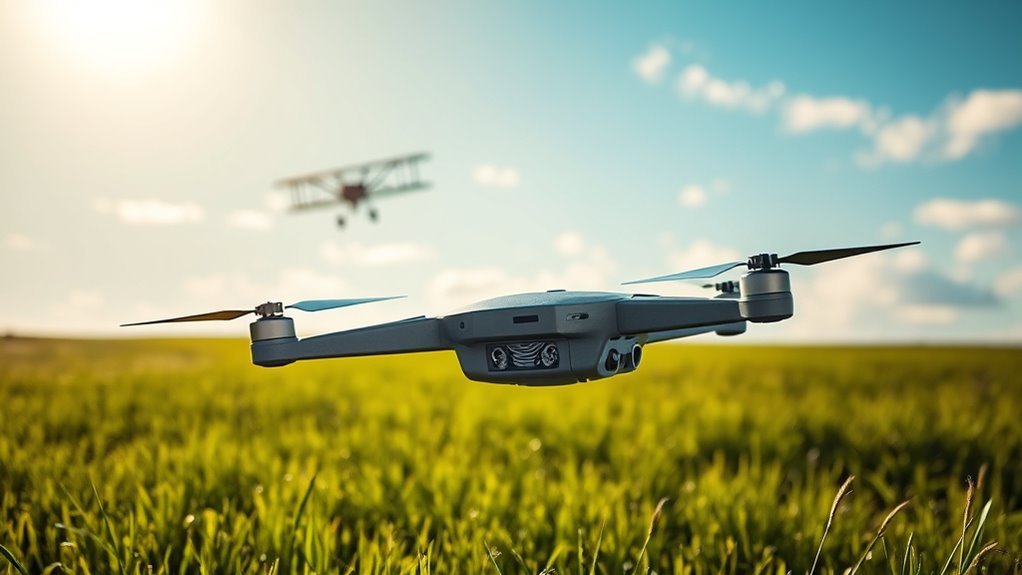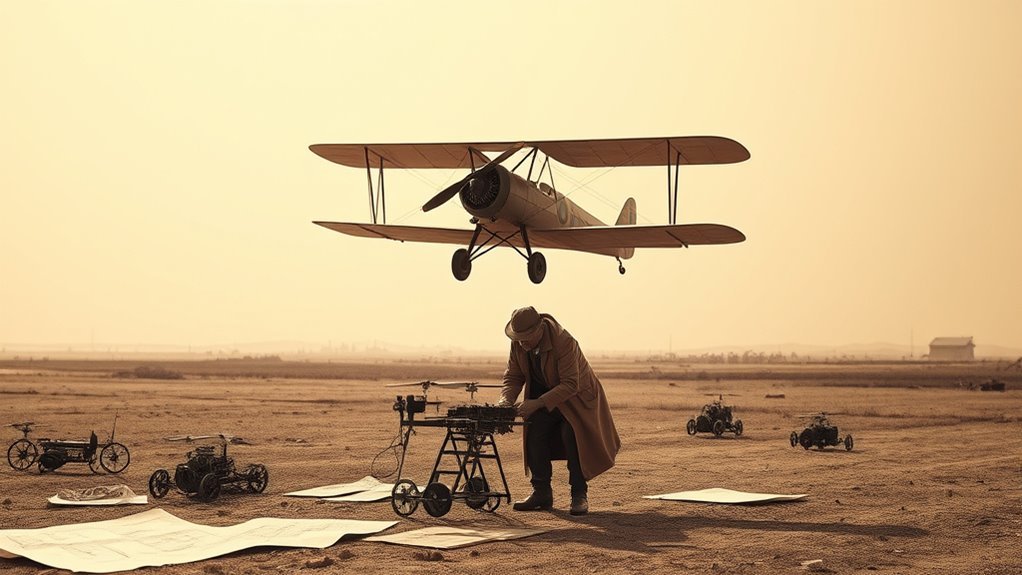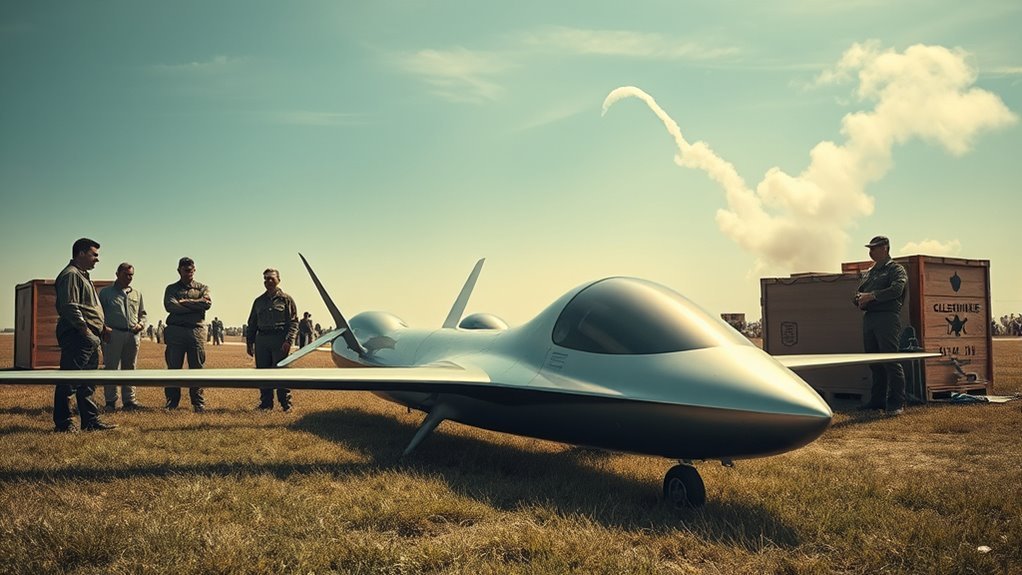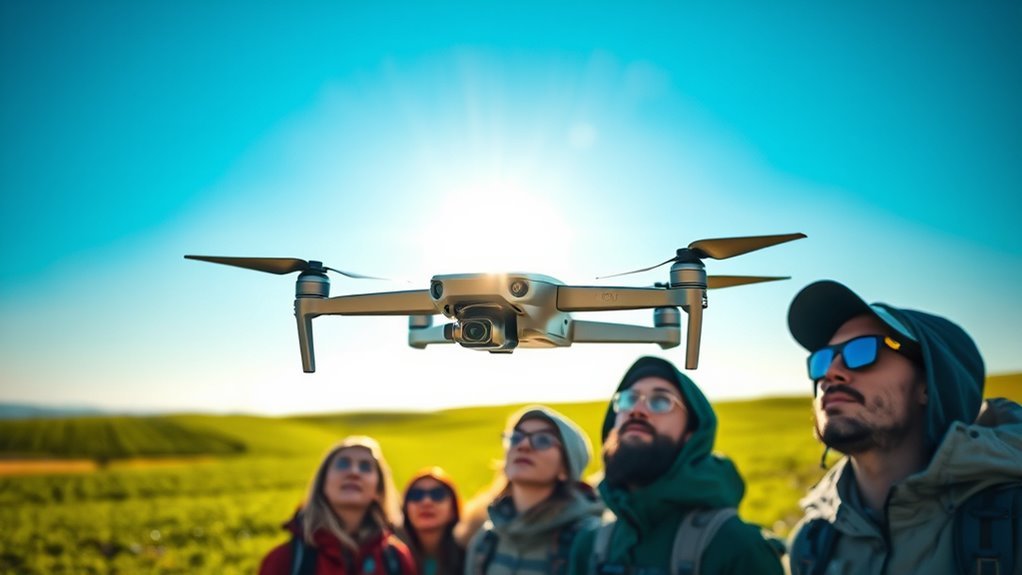The origins of drone technology can be traced back over a century, beginning with early aerial reconnaissance in military conflicts. Innovations during World War I introduced remote-controlled technology, while World War II saw the development of unmanned vehicles for tactical purposes. The Cold War further advanced surveillance capabilities. Today, drones have shifted from military use to civilian applications, raising both regulatory challenges and ethical considerations. Explore how these factors continue to shape the future of drone technology.
The Early Beginnings: A Brief History of Aerial Warfare

While aerial warfare may seem like a modern concept, its origins trace back over a century. The initial forays into aerial reconnaissance were pivotal, establishing the groundwork for what would evolve into drone warfare. Early aircraft were adapted for reconnaissance missions, enabling military strategists to gather intelligence from the skies, thereby enhancing tactical decision-making. This capability marked a significant shift in combat methodologies, emphasizing the importance of information over brute force. As technology advanced, the military began experimenting with unmanned aerial vehicles, laying the foundation for modern drone warfare. These developments not only transformed military operations but also raised ethical questions regarding surveillance and engagement, highlighting the delicate balance between security and individual freedoms in the pursuit of effective aerial strategy. The evolution of drones has led to innovations such as advanced sensor technology, further enhancing operational effectiveness in various applications. Understanding signal attenuation is crucial for optimizing flight paths and ensuring reliable data transmission during reconnaissance missions.
World War I Innovations: The Birth of the Drone Concept

In World War I, the concept of remote-controlled technology emerged, laying the groundwork for modern drone development. You’ll see how early aerial warfare spurred innovations that would eventually lead to the creation of unmanned aircraft. This period marked a pivotal shift in military tactics, as the potential for remote engagement began to take shape.
Early Aerial Warfare
As World War I unfolded, nations quickly recognized the potential of aerial warfare, paving the way for innovations that would eventually lead to the concept of drones. Early aerial tactics focused on reconnaissance and targeted strikes, highlighting a shift in military strategy. The introduction of armed aircraft forced a reevaluation of traditional combat methods, as commanders sought to integrate these new technologies effectively. However, this also raised critical drone ethics issues, particularly regarding the implications of remote targeting and civilian safety. As you explore these developments, consider how these innovations not only revolutionized warfare but also laid the groundwork for future unmanned systems. The lessons learned during this era continue to influence today’s discussions on the ethical use of drone technology in modern conflicts.
Remote-Controlled Innovations
Although many early aerial innovations focused on piloted aircraft, World War I marked a pivotal shift toward remote-controlled technologies that laid the groundwork for modern drones. During this period, the concept of remote control began to take shape with inventions like the Kettering Bug, an early cruise missile prototype. These developments not only aimed to enhance combat effectiveness but also opened avenues for aerial photography, allowing for reconnaissance without risking pilot lives. As you analyze these innovations, consider how they revolutionized warfare and surveillance. The desire for autonomy in military operations reflects a broader quest for freedom in technology. Understanding these early remote-controlled innovations gives you insight into the evolution of drone applications today, merging strategic advantage with operational safety.
World War II Developments: Advancements in Unmanned Flight

During World War II, early unmanned aerial vehicles emerged as critical tools for military strategy and reconnaissance. These innovations not only advanced aerial technology but also shaped the future of unmanned flight applications. Understanding these developments highlights the pivotal role they played in transforming warfare tactics.
Early Unmanned Aerial Vehicles
While the notion of unmanned flight has roots that predate World War II, it was during this period that significant advancements in drone technology emerged, fundamentally altering military tactics and strategies. The development of early unmanned aerial vehicles (UAVs) showcased the historical significance of this technological evolution. Innovations like the Radioplane OQ-2, pioneered by actor and inventor Howard Hughes, demonstrated the potential of remote-controlled aircraft for reconnaissance and training. These UAVs allowed operators to gather intelligence without risking human lives, marking a pivotal shift in warfare. As you explore this technological landscape, you’ll recognize how these early efforts laid the groundwork for modern drone applications, emphasizing autonomy, efficiency, and the quest for strategic advantage in aerial operations.
Military Applications and Innovations
As military strategists recognized the advantages of unmanned flight, World War II became a catalyst for rapid advancements in drone technology. Innovations in drone warfare transformed aerial surveillance, providing critical insights without risking human lives. Key developments included:
- Radioplane OQ-2: The first mass-produced drone, used for target practice.
- Operation Aphrodite: Kamikaze-style drones for bombing missions.
- Aerial reconnaissance: Drones equipped with cameras for intelligence gathering.
- Decoy technology: Drones designed to mislead enemy radar systems.
- Remote control systems: Enhanced operational range and precision.
These strides not only shaped military strategy but also laid the groundwork for the sophisticated drone systems we see today, empowering nations to conduct operations with increased efficiency and safety.
The Cold War Era: Drones in Surveillance and Reconnaissance
Although the Cold War is often characterized by direct military confrontations and ideological battles, it also spurred significant advancements in surveillance technology, particularly through the development of drones. During this period, nations recognized the strategic necessity of aerial surveillance to monitor adversaries and gather intelligence without risking human lives. Drones evolved from simple radio-controlled aircraft into sophisticated platforms equipped with cameras and sensors, capable of flying long distances and capturing essential data. These innovations allowed for real-time reconnaissance, enhancing situational awareness while maintaining deniability in intelligence operations. The Cold War’s emphasis on stealth and precision laid the groundwork for future drone technologies, illustrating how geopolitical tensions can catalyze advancements that ultimately shape national security strategies and the pursuit of freedom.
The Rise of Hobbyist Drones: From Military to Consumer
The shift from military drones to hobbyist models marks a significant shift in technology and consumer behavior. Military innovations have paved the way for consumer adoption, driven by advancements in accessibility and affordability. As you explore this evolution, you’ll notice key trends that highlight the growing interest in recreational drone use. This transformation is largely influenced by innovative designs that integrate cutting-edge technology, making drones more appealing to a broader audience. The AI integration featured in modern drones enhances user experience and operational capabilities, further solidifying their place in consumer markets.
Military Origins Explained
While many people associate drones with recreational use today, their origins lie firmly in military applications. As military strategies evolved, drone technology became integral for surveillance and combat. You can see this evolution through key developments:
- The creation of early unmanned aerial vehicles (UAVs) for reconnaissance.
- Use of drones in targeted strikes, minimizing risk to personnel.
- Enhanced payload capabilities for diverse missions.
- Real-time data transmission for tactical advantages.
- Shift from military-exclusive use to broader consumer markets.
These advancements illustrate how military needs spurred drone evolution, laying the groundwork for today’s consumer technology. Understanding this context not only highlights the significance of drones but also reflects the ongoing quest for freedom in accessing and utilizing such innovations.
Consumer Adoption Trends
As drone technology advanced from military applications to consumer markets, hobbyist interest surged, transforming the landscape of aerial innovation. You’ve likely noticed the rapid adoption of drones among enthusiasts, driven by changing consumer preferences for affordable, user-friendly devices. The market growth in this sector reflects a broader desire for personal exploration and creativity, empowering individuals to capture unique perspectives and engage in aerial photography, racing, and more. As manufacturers respond to demand, features like GPS stabilization and HD cameras become standard, enhancing user experience. This evolution signifies not just a shift in technology but also a cultural embrace of freedom in flight, democratizing access to aerial capabilities that were once exclusive to military and professional domains.
Technological Breakthroughs: The Role of Robotics and Electronics
Advancements in robotics and electronics have fundamentally reshaped drone technology, enabling unprecedented levels of autonomy and functionality. With the integration of robotic automation and electronic miniaturization, drones can perform complex tasks with minimal human intervention.
Consider the following breakthroughs:
- Autonomous navigation: Drones can now navigate environments using advanced sensors and AI algorithms.
- Real-time data processing: Enhanced onboard processors enable immediate analysis of collected data, facilitating faster tactical responses in dynamic situations.
- Compact design: Miniaturized components allow for lighter drones with increased payload capacities.
- Improved battery technology: Longer flight times result from advancements in energy storage solutions.
- Versatile applications: From agriculture to search-and-rescue, drones now adapt to diverse operational needs.
These technological innovations have expanded the horizons of what drones can achieve, with AI-enhanced obstacle avoidance ensuring safer flights.
The Civilian Drone Revolution: Applications Beyond the Military
The rapid advancements in drone technology have paved the way for a civilian revolution, transforming how various industries operate. You’ll find commercial applications across sectors, from agricultural uses like crop monitoring to delivery services that enhance logistics efficiency. Drones excel in aerial photography, offering new perspectives for real estate and tourism. In search and rescue missions, they provide critical data, improving disaster response times. Environmental monitoring becomes more effective with drones, enabling precise tracking of wildlife conservation efforts, as well as real-time monitoring of environmental conditions that support sustainable practices. Additionally, infrastructure inspection benefits from drones, allowing for safer, quicker assessments of bridges and power lines. Finally, mapping surveys utilize drone technology to create detailed topographical maps, facilitating urban planning and land management. These innovations empower society, promoting freedom and efficiency. Moreover, drones are enhancing medical supply delivery by reducing delivery times, which is crucial in public health responses.
Regulatory Challenges: Navigating Airspace and Safety
While the proliferation of drone technology offers numerous benefits, maneuvering through the complex landscape of regulatory challenges is essential for ensuring safe and effective operations. Understanding airspace regulations and adhering to safety standards can empower you to utilize drones without compromising safety. Here are key considerations:
Navigating regulatory challenges is crucial for safe and effective drone operations. Understanding airspace rules enhances both safety and freedom.
- Airspace classification: Know the different classes of airspace and their restrictions.
- Operational limitations: Understand height restrictions, no-fly zones, and other operational guidelines. Additionally, adhering to FAA regulations is crucial for compliance and operational safety.
- Pilot certification: Familiarize yourself with licensing requirements for drone operators.
- Insurance requirements: Assess the need for liability insurance for drone operations.
- Data privacy laws: Be aware of regulations related to data collection and privacy implications. Additionally, ensuring compliance with local regulations is crucial in maintaining freedom and safety while flying.
Navigating these challenges will not only enhance safety but also expand your operational freedom.
The Future of Drone Technology: Trends and Innovations
As technology continues to evolve, drone capabilities are increasingly expanding, promising significant transformations across various sectors. Integrating artificial intelligence, drones are set to revolutionize drone delivery methods, enhancing efficiency and speed. In agricultural applications, drones equipped with advanced sensors will optimize crop monitoring and yield predictions. Environmental monitoring will benefit from real-time data collection, aiding in climate change mitigation. For disaster response, drones can swiftly assess damage and deliver supplies. Urban planning will leverage aerial photography for smarter city designs. Swarm technology enables multiple drones to work collaboratively, improving operational effectiveness. For instance, the Shooting Star 2’s decentralized coordination allows for precise formations that can enhance collaborative missions. However, successful implementation relies on developing regulatory frameworks and fostering industry partnerships to guarantee safety and innovation in this rapidly growing field. The use of AI-powered obstacle avoidance will further enhance the safety and performance of drone operations.
The Impact of Drones on Society: Opportunities and Concerns
Drones have emerged as powerful tools that can reshape various aspects of society, offering both significant opportunities and notable concerns. As you explore their impact, consider the following key points:
- Economic opportunities: Drones can enhance efficiency in industries, creating new jobs.
- Emergency response: They provide real-time data during disasters, improving rescue efforts.
- Environmental monitoring: Drones facilitate the tracking of wildlife and pollution levels.
- Aerial delivery: They revolutionize logistics, offering faster delivery solutions.
- Privacy concerns: The use of drones raises ethical questions related to surveillance and data collection.
- Furthermore, innovations such as advanced GPS positioning in drones contribute to their effectiveness in various applications, enhancing navigation and stability.
Balancing public safety with surveillance ethics is essential as society navigates these advancements, ensuring that innovation doesn’t infringe on personal freedoms.
Frequently Asked Questions
Who Were the Key Inventors Behind Early Drone Technology?
You’ll find early pioneers like Nikola Tesla and Reginald Denny essential to drone technology’s development. Their technological advancements laid the groundwork for modern drones, highlighting innovation’s role in achieving freedom in aerial exploration and surveillance.
How Have Drones Impacted Wildlife Conservation Efforts?
You’ll find drones revolutionizing wildlife conservation, akin to modern-day rangers. They’re monitoring habitats, tracking populations, and collecting data with precision, enabling researchers to safeguard ecosystems more effectively than ever before, fostering a harmonious balance with nature.
What Materials Are Commonly Used in Drone Construction?
When constructing drones, you’ll find composite materials and lightweight frames are commonly used. These materials enhance performance, providing durability while minimizing weight, essential for maximizing flight efficiency and extending operational capabilities in various applications.
Are There Ethical Concerns Regarding Drone Usage in Civilian Life?
Yes, there’re significant ethical concerns about drone usage in civilian life, particularly regarding privacy issues and military implications. Drones can intrude on personal space, raising questions about surveillance, consent, and the potential for misuse in conflict situations.
How Do Drones Communicate With Their Operators?
Drones communicate with their operators through signal transmission, utilizing radio frequencies or Wi-Fi. The operator interface allows real-time control and feedback, ensuring efficient navigation and data exchange, while maintaining a connection essential for operational effectiveness.

